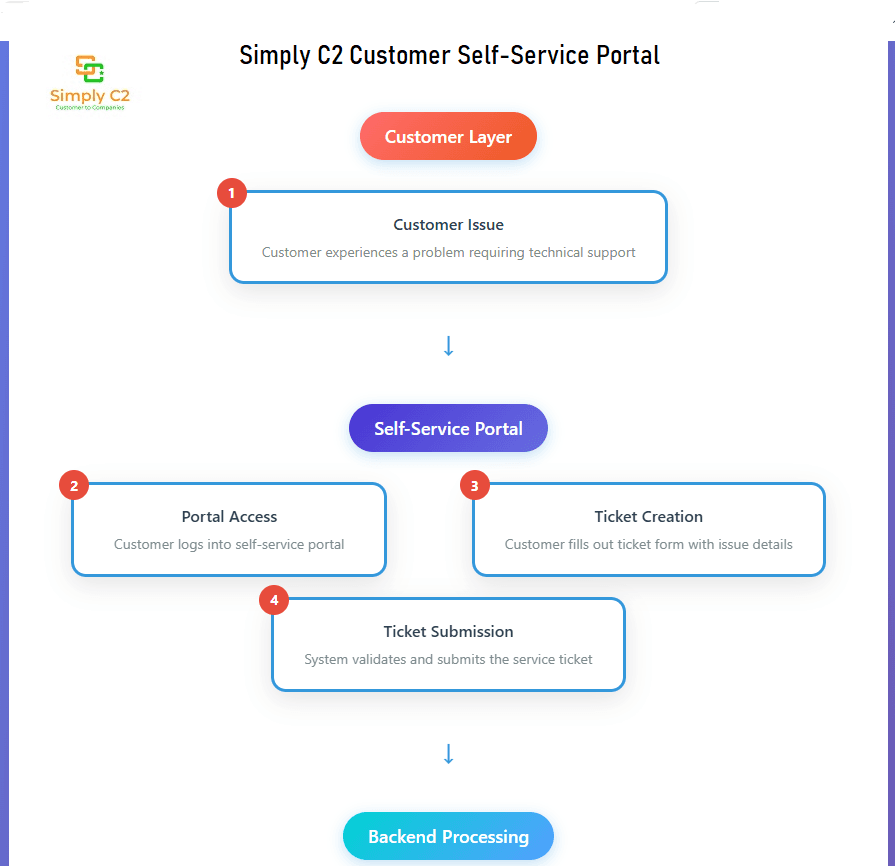The High Cost of Low Tech: How A Self-Service Portal Helps

The Strategic Cost of Poor Service
Customer service isn’t just a post-sales function — it’s a strategic pillar of brand value and a recurring source of revenue risk (or gain) for manufacturers. A Customer Self-Service Portal helps customers feel empowered, frees up their time and reduces the burden on your call centre.
Customers need to see post sales service differentiator
For companies making appliances, industrial equipment, or systems installed on customer premises, post-installation service defines customer loyalty. Remember, poor service damages your brand far more deeply than product defects.
Consider this:
- 89% of B2B customers say poor support is a deal-breaker.
- While, 76% of equipment buyers consider service capability when choosing vendors.
- Also, More than 50% of manufacturer complaints on B2B review platforms relate to post-sale support.
But the damage doesn’t stop at churn. Inefficient service operations lead to cost escalations that bleed margins:
- Repeat technician visits due to lack of parts or wrong diagnosis
- Field teams waiting for dispatch instructions or approvals
- Lack of real-time tracking, SLA enforcement, or customer communication
The kicker? Even though many CXOs don’t see the cost of poor service because it’s distributed and poorly tracked, it’s buried in return visits, delayed escalations, or lost referrals — and rarely accounted for in strategic planning.
If service operations are still considered a “cost center” or are left to aging tools and processes, you’re leaving efficiency, revenue, and reputation on the table.
Common Gaps in Manufacturing Service Workflows
Most manufacturing companies did not design their customer service for the complexity of modern business. Especially when it involves:
- Distributed field teams
- Long product lifecycles
- Warranty and AMC workflows
- Customer ticket escalation
- Region-wise technician allocation
Yet the reality is: many still operate with a patchwork of tools.
| Legacy Tool | What It Was Designed For | What It Can’t Handle |
|---|---|---|
| Spreadsheets | Internal reporting | Service SLAs, escalations, field scheduling |
| Email threads | Simple communication | Multi-party coordination, ticket audit trail |
| Generic CRMs | Sales and marketing | Field visits, technician tracking, ticket dispatch |
| Homegrown tools | Initial scale | Can’t scale, limited analytics, poor UX |
Let’s take a typical service workflow from a customer’s point of view:
I log a complaint → No confirmation received → I call again → Technician arrives late → Lacks part → Returns again in 3 days → No feedback loop
Now the internal view:
Ticket comes via email → Manually logged → Field head checks availability → Calls technician → No tracking → Excel updated post-facto
Multiply this by hundreds of machines, multiple regions, warranty rules, SLAs, field teams — and chaos ensues. Legacy tools don’t offer accountability, scalability, or customer visibility.
That’s why leading manufacturers are shifting to field-service-first platforms that are made to handle these complexities.
Why A Customer Self-Service Portal helps with Modernization Agenda
This is not an IT upgrade. This is a core strategic transformation.
Customer service is no longer about responding. It’s about owning the full customer lifecycle — and CXOs are the only ones who have the cross-functional authority to lead this change.
Service Ticket Process Flow
Customer Actions
Portal Interface
System Processes
Decision Points
Final Assignment
Like the diagram? Do you need to convince your internal team? Mail us at simply AT simplyc2 DOT com.
How self-service portal works
The basic idea of a customer self-service portal is to provide visibility to the customer about his equipment health.
To be effective, these bare minimum functionality for the customer must be implemented.
- Maintain installed base of equipment: The customer must be able to see (and optionally add and keep updated) equipment that he owns. With all details like date of warranty expiry, contract renewal dates etc.
- Manage his own profile: The customer should be able to see how his details are captured at the vendor side; his name, address, contact details.
- Log tickets: Customer should be able to log service requests.
- Track ticket progress: The customer should be able to see the various stages of the ticket as it moves from logged to assigned to working to close.
- Approve estimates: The customer should be able to approve repair estimates within the self-service portal.
As we can see, the idea is to empower the customer by letting him have full visibility of the repair process.
Here’s How A Self-Service Portal is a Strategic Win
- Impacts retention: Even happy product users churn when post-sale support fails.
- Protects margins: Streamlined service workflows save hours per technician per week.
- Creates revenue opportunities: AMC upgrades, upsells, and reputation-driven inbound interest.
- Feeds product feedback loops: Service data tells you what fails, how often, and where.
- Reduces chaos: No more last-minute escalations or irate customer calls to senior management.
Yet in many companies, service modernization is treated like a backend tech issue or a departmental pilot.
🚨 That’s a mistake.
The transformation should be top-down, cross-functional, and backed by CXO visibility. Start with the self-service portal and see your customer satisfaction soar.
Just as you wouldn’t leave ERP strategy to a warehouse manager, you shouldn’t leave service digitization to a local technician supervisor.
Instead, CXOs need to lead with clear objectives, ownership, and outcomes:
| Strategic Objective | Metric to Track | Ownership |
|---|---|---|
| Improve customer retention | Repeat business rate | Chief Customer Officer |
| Reduce service costs | Avg. cost per ticket | CFO / COO |
| Drive team productivity | Tickets per technician | VP – Service |
| Improve NPS / CSAT | Customer feedback, SLA adherence | CXO Suite |
With the right data, the transformation becomes measurable and aligned with enterprise KPIs — not just operational fire-fighting.
SimplyC2: A Platform Built for Manufacturers Who Take Service Seriously
Enter SimplyC2 — a unified, field-service-first platform built specifically for manufacturers with large installed bases, distributed field teams, and a desire to transform customer service into a strategic advantage.
Key Capabilities:
- 🛠️ Technician Dispatching & Scheduling
Assign the right person at the right time with real-time visibility into team availability, workload, and skill sets. - 📦 Parts & History Tracking
See which part was replaced, when, by whom — and avoid repeated visits or misdiagnosis. - 📲 Customer Self-Service Portal
Allow your customers to raise complaints, upload images, and track service progress — without calling your helpdesk. - 📊 Service Analytics
Track every SLA breach, ticket cycle time, field team productivity, and customer feedback — all in real time. - 🔐 Deployment Flexibility
Choose to host it on your own domain, infrastructure, or go with our cloud version. You control the data. - ⚙️ AMC & Warranty Workflow Support
Handle complex entitlement rules, multiple geographies, and service conditions effortlessly.
💬 Final Word: Modernizing Customer Service Isn’t Optional
In an industry where customer loyalty hinges on service experience, modernizing your support workflows is no longer a luxury — it’s a competitive necessity.
And it’s not just about tools. It’s about mindset, metrics, and momentum — all of which start at the CXO level.
💡 Want to see how SimplyC2 transforms your field support experience?
👉 Book a Free 20-Minute Strategy Call


Leave a Reply